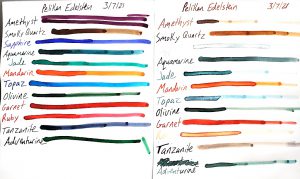One of the many great aspects of marrying a scientist is the gadgetry. Intrigued by my ink-fast tests with UV light, Dawn decided to get a professional pH meter to test our ink for corrosiveness. If you remember basic chemistry from high school…which I barely do…you will remember that we have acid on one side of a scale and base/alkali on the other. The scale ranges from 0 to 14. 7 is neutral like distilled water. The further you move away from 7 in either direction is more corrosive. The 0 side is acid and the 14 side is base/alkali.
You would think that all inks are hovering around a 7 to be safe in your pen and on paper. We certainly did.
Holy cats! We were wrong.

First you saw these Pelikan Edelstein inks in our UV ink fast test. Now we’re going back and checking their pH balance!
For years I told people…as I was told by many pen collectors and dealers before me…that you can always trust simple blue and black inks from the major pen manufacturers. However, just our initial testing indicates that might not be the best advice any longer.
Before I go on, let me preface the following by saying that we are not chemists. We feel confident in our results from our testing. However, we do not know the chemistry of the ink interacting with ink sacs, celluloid, gaskets, seals and other assemblies inside your pens. Our pH testing is simply raw data we gather from bottles of ink we have collected. Yet, it might help shed some light if you are experiencing trouble with certain inks interacting poorly with your vintage or modern pens over time.
Having recently written about Pelikan Edelstein inks in an ink-fast test, I thought I would revisit these inks for our pH testing. For those keeping score at home our meter and inks were tested and calibrated at 24ºC.
Pelikan Edelstein Amethyst 5.6
Pelikan Edelstein Aquamarine 3.3
Pelikan Edelstein Aventurine 6.4
Pelikan Edelstein Garnet 6.5
Pelikan Edelstein Jade 5.3
Pelikan Edelstein Olivine 6.0
Pelikan Edelstein Ruby 7.9
Pelikan Edelstein Sapphire 3.7
Pelikan Edelstein Smokey Quartz 6.5
Pelikan Edelstein Tanzanite 7.3
Pelikan Edelstein Topaz 6.4
Pelikan Old Version Violet 2.7
Pelikan Modern Violet 3.4
Pelikan Brilliant Red 6.9
Again, I’m not a chemist, and I have not studied how these inks interact chemically with ink sacs and other pen parts.
That said, what really strikes me as fascinating is that the “traditionally safe” blues such as Sapphire and Aquamarine are really acidic. I love Edelstein Sapphire and use it more than any of these other colors, and I would never have guessed it was as acidic at it is.
Also fascinating, I’ve been told for years never to put red ink in an ink sac, but Garnet, Ruby and Brilliant Red are among the closest inks to test near pH neutral.
Again, the chemicals in the ink might interact differently with the chemical compositions of our pens, but we find this to be a really fun look into our favorite inks. Many more UV and pH tests to come!


 Shopping Cart
Shopping Cart




